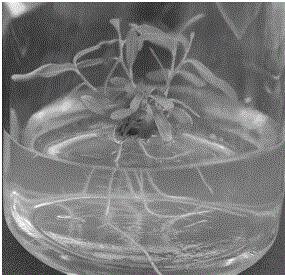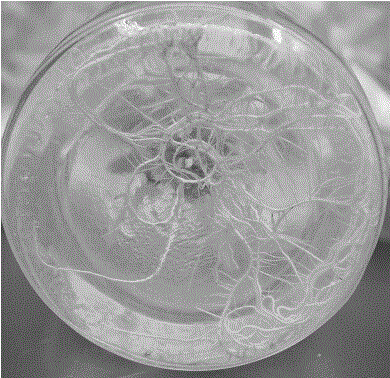Preparation method of salix suchowensis resistant seedlings
A technology of willow resistance and dustpan, applied in the field of genetic engineering, can solve the problems of limited research, preliminary exploration of willow trees in the regeneration system, and no breakthrough research results have been obtained.
- Summary
- Abstract
- Description
- Claims
- Application Information
AI Technical Summary
Problems solved by technology
Method used
Image
Examples
Embodiment 1
[0029] Dustpan willow tissue-cultured seedlings are subcultured in the form of stem segments differentiated into adventitious buds. The basic medium used for cultivation is 1 / 2WP, sucrose 25-30g / L, pH 5.8, crystal agaric 2g / L, 121±1°C, sterilized for 18min. Additional auxins, cytokinins and antibiotics were filter-sterilized, added to the culture medium cooled to about 40°C after autoclaving. On the test-tube plantlets that have been subcultured for about 1 month, select young stem segments with basically the same growth state, cut them into about 1-2 cm long stem segments as explants, and inoculate them into the differentiation medium for pre-cultivation, such as figure 1 shown. The culture temperature is 25±2°C, the light is 3000-4000lux, the light time is 16h / d, and the pre-culture is 2-3d. Pick a single colony of Agrobacterium DH5α and inoculate it into LB liquid medium, add kanamycin 40mg / L, shake culture at 28°C (220-230rpm), overnight; transfer 1mL to 50mL LB liquid m...
Embodiment 2
[0032] The basic medium can only maintain the survival of plants and the minimum physiological activity requirements, so it is necessary to add cytokinins KT and 6-BA to the basic medium. The preparation method of Dupan willow resistant seedlings is the same as in Example 1, wherein different concentrations of cytokinins are used to induce adventitious buds, and the concentrations and results are shown in Table 1 and Table 2.
[0033] Table 1 Effect of 6-BA on induction of adventitious buds of Dustpan willow
[0034] 6-BA concentration (mg / L)
Browning rate%
0.1
58.9±2.1
13.3±0.5
0.5
92.2±3.0
14.4±1.3
1.0
74.4±1.7
24.4±2.2
1.5
46.7±1.3
67.8±1.9
2.0
27.8±0.8
84.4±2.7
[0035] Table 2 Effect of KT on induction of adventitious buds of Dustpan willow
[0036] KT concentration (mg / L)
Browning rate%
0.1
63.3±1.6
17.7±2.3
...
Embodiment 3
[0041] The basic medium can only maintain the survival of plants and the minimum physiological activity requirements, so TDZ and NAA need to be added to the basic medium. The preparation method of the resistant seedlings of Dustpan willow is the same as in Example 1, wherein different concentrations of TDZ and NAA are used for cultivation, and the results are shown in Table 3.
[0042] Table 3 Effects of combinations of different concentrations of TDZ and NAA on proliferation of adventitious buds
[0043] TDZ (mg / L)
NAA(mg / L)
Bud Proliferation Coefficient
0.001
0.01
0.90
0.001
0.03
1.23
0.001
0.05
1.74
0.003
0.01
2.31
0.003
0.03
2.74
0.003
0.05
2.93
0.005
0.01
3.48
0.005
0.03
3.31
0.005
0.05
3.05
[0044] Bud proliferation coefficient = number of proliferating explants / total number of explants × 100%.
[0045] It can be s...
PUM
 Login to View More
Login to View More Abstract
Description
Claims
Application Information
 Login to View More
Login to View More - R&D
- Intellectual Property
- Life Sciences
- Materials
- Tech Scout
- Unparalleled Data Quality
- Higher Quality Content
- 60% Fewer Hallucinations
Browse by: Latest US Patents, China's latest patents, Technical Efficacy Thesaurus, Application Domain, Technology Topic, Popular Technical Reports.
© 2025 PatSnap. All rights reserved.Legal|Privacy policy|Modern Slavery Act Transparency Statement|Sitemap|About US| Contact US: help@patsnap.com



